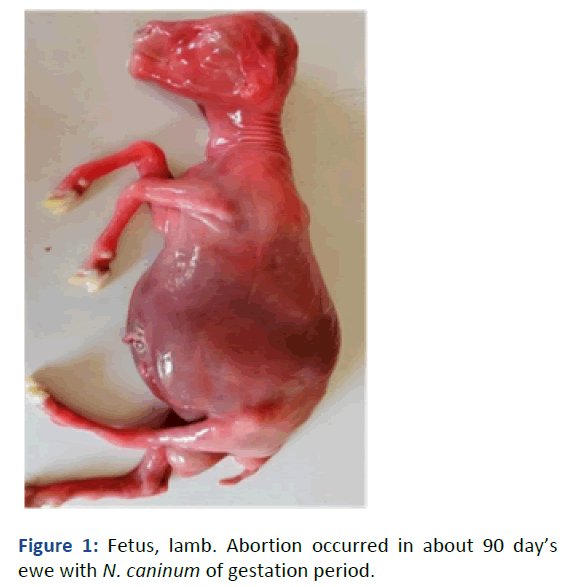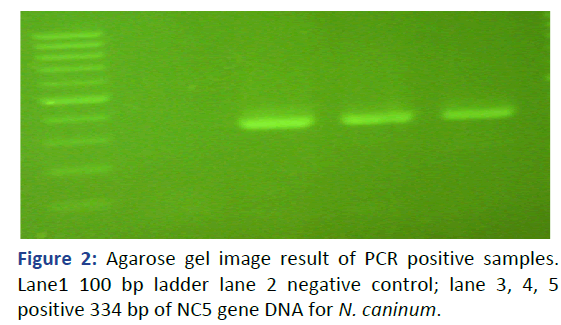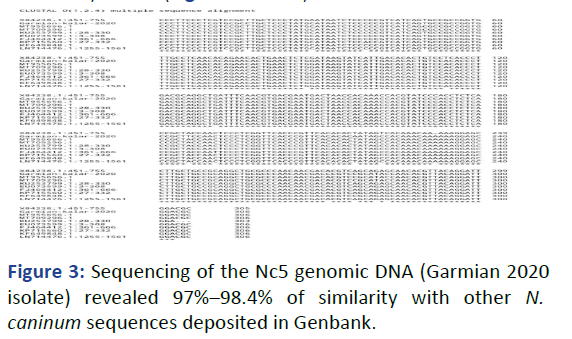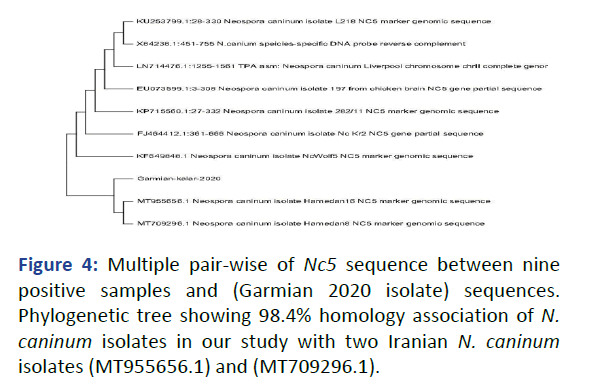Research Article - (2023) Volume 9, Issue 3
Molecular Identification of Neospora caninum in Aborted Sheep in Garmian Region/Kurdistan of Iraq
Hiwa Essa*
Department of Veterinary, Pasteur Institute of Iran, Tehran, Iran
*Correspondence:
Hiwa Essa, Department of Veterinary, Pasteur Institute of Iran, Tehran,
Iran,
Email:
Received: 04-Apr-2023, Manuscript No. IPBMBJ-23-16066;
Editor assigned: 06-Apr-2023, Pre QC No. IPBMBJ-23-16066 (PQ);
Reviewed: 20-Apr-2023, QC No. IPBMBJ-23-16066;
Revised: 05-Jun-2023, Manuscript No. IPBMBJ-23-16066 (R);
Published:
12-Jun-2023, DOI: 10.36648/2471-8084.9.5.41
Abstract
Neospora caninum is an intracellular protozoan parasite associated with bovine and ovine abortion. Little is known about the extent of Neospora infection in infected populations of animals. This parasite is a worldwide apicomplexan protozoan with a variety of animal hosts. The earlier report of the parasite was described in 1984 in puppies with signs of encephalomyelitis and myositis. Neosporosis is considered a major cause of abortion in many cattle-producing countries. In sheep, the first infection with N. caninum was diagnosed in a congenitally infected lamb in England. This study aims to estimate the existence of Neospora caninum in aborted sheep in the Garmian region in Kurdistan/ Iraq. There is little information about the prevalence and existence of N. caninum in aborted animals in Kurdistan and Iraq by PCR and diagnosis is only done by serological methods. The Polymerase Chain Reaction or PCR was used for the detection of Neospora caninum in the placenta tissues of aborted sheep from (89) aborted sheep in mating season 2021. The results of the study showed that 6 (6.7%) out of (89) fetal samples of ovine aborted fetuses by using PCR were positives. Our results suggest that the infection with N. caninum is existed and was detected in aborted fetuses. Furthermore, the study is the first one to identify N. caninum in this region and amended that this protozoan is one of the main causative agents of abortion via PCR technique.
Keywords
Abortion; Fetuses; Intracellular; Neospora; N5 gene
Introduction
Prostate Neospora caninum are intracellular protozoan
parasites associated with bovine and ovine abortion. Little is
known about the extent of Neospora infection in infected
populations of animals. Neospora caninum is a worldwide
apicomplexan protozoan with a variety of animal hosts. The
earlier report of the parasite was described in 1984 in puppies
with signs of encephalomyelitis and myositis. Neosporosis is
considered a major cause of abortion in many cattleproducing
countries. In sheep, the first infection with N. caninum was diagnosed in a congenitally infected lamb in
England. Neospora, Toxoplasma and Sarcosystosis are genera
of sarcocystidae family. The N. caninum life cycle is divided
into three infectious stages which are tachyzoites, tissue cysts,
and oocysts. The first two stages are found intracellularly in
the intermediate hosts, whereas oocysts which are
approximately measure 12 μm in diameter are excreted
unpopulated in feces and sporulation occurs outside the host.
The final host of Neospora is a dog which is also stated as an
intermediate host. Some studies indicate that coyotes (Canis
latrans), dingoes (Canis lupus dingo), red foxes (Vulpes vulpes), and grey wolves (Canis lupus), are also measured as
definitive hosts of this protozoan. Dogs, the definitive hosts,
infect via ingestion of infected tissues with tachyzoites or
tissue cysts from several intermediate hosts. The natural
intermediate hosts of neosporosis are cattle, sheep, goats,
camels and water buffalos, some birds and cats, mice, gerbils
and monkeys are experimental intermediate hosts. It occurs
occasionally in horses and deer.
Sheep can be infected either transplacentally (vertically,
congenitally) from an infected dam to her fetus during
pregnancy or horizontally by ingestion of sprozoites
containing oocysts which are shed by the definitive host. N.
caninum can cause abortion in sheep with fetal
mummification, embryo resorption, still birth, and the birth of
weak or apparently healthy but congenitally infected
offspring. Lesions of ovine cerebral neosporosis were acute
non-suppurative meningoencephalitis and mild to moderate
non-supportive myelitis.
Until recent years, little evidence that the disease become a
significant field problem in sheep was recorded, however, in
some places, naturally occurring ovine neosporosis has been
reported in Japan, South America and Switzerland. When the
fetal immune system is little developed at the early gestation
periods, the infection can be fatal with fetal resorption or
abortion, while the exposure to older fetuses with a better
developed immune system may result in the birth of clinically
normal but congenitally infected animals. Although reports of
reproductive failure and abortion have been reported in many
studies, information about the description and detection of
nucleic acids resulting from neosporosis in sheep is still
deficient. The first report about the association between N.
caninum and cases of abortion in naturally infected sheep was
first mentioned by Hassig, et al., through PCR in the brain of
fetuses from aborted sheep. Many studies about the
detection of abortion induced by protozoa have been based
on histopathological determination for many years this
technique cannot make an accurate differentiation between
infections with N. caninum from that with Toxoplasma gondii because of the morphological similarity of both parasites.
Thus, to overcome these methodological limitations more
sensitive and specific techniques have been applied to enable
the detection of the parasite DNA and genetic
characterization. PCR allows fast and methodically highly
sensitive identification of N. caninum by subsequent and
amplification of the parasite specific DNA sequences in
different tissues likes brain, lung, liver, kidney, semen, and
placenta. The study aimed to estimate the existence of Neospora caninum in aborted sheep in the Garmian region in
Kurdistan/Iraq by using PCR [1-4].
Materials and Methods
The study area is located in the Southeastern part of the
region of Iraqi Kurdistan, between two latitudes(33° N and
35°N) and longitudes (41°, 44°)E. As they challenged the
Sulaymaniyah governorate from the North and the provinces
of Salah al-Din and Diyala from the West and South,
respectively, while its Eastern borders, representing the international border with the Islamic Republic of Iran, at a
distance of 153 km [5-11].
Sampling and Data Collection
A total of 89 samples including sheep aborted placental
tissues were collected from aborted flocks suspected to be
infected with N. caninum. During mating season 2021, (89)
flocks, with a history of reproductive disorders like abortions,
stillbirth, weak birth were investigated. Samples were
collected from (89) different flocks from 23 villages. The
samples were from villages distributed in the Garmian region
from al Sulaymaniyah province in Kurdistan of Iraq. Collected
samples were preserved freezing at −20°C until the PCR and
DNA extractions were implemented (Figure 1) [12,13].

Figure 1: Fetus, lamb. Abortion occurred in about 90 day’s
ewe with N. caninum of gestation period.
DNA Extraction
Diagnostic samples were collected from the placenta of
aborted fetuses for genomic DNA diagnosis about 5 g–10 g of
each sample was taken selectively from aborted fetuses, and
preserved in freezing -20°C for future DNA extractions.
Genomic DNA was extracted from about 20 mg–50 mg of each
sample and DNA extraction was done according to the Addbio
tissue extraction kit (South Korea). Finally, 100 μl volume of
eluted DNA was obtained and stored at -20°C until PCR
analysis.
PCR Primers and Master-Mix
The PCR assay using the primers specific for Neospora
caninum with an amplified product of 334 bp (Figure 2).
Oligonucleotide primers were designed according to Muller, N
et al., for amplification of the NC5 gene of N caninum primers
used in the PCR reaction were synthesized by Macro gene (S,
Korea). The primers were received in lyophilized form and suspended in RNASE free water to reach a final concentration
of 10 Pmol/μl designed to amplify a specific segment of 334
bp. Neospora caninum specific primer pair Np21 forward
(GTGCGTCCAATCCTGTAAC) and Np6 Reverse
(CTCGCCAGTCAACCTACGTCTTCT) 334 bp amplicons that
anneal to a repetitive region of the parasite genome and used
for molecular diagnosis of the parasite.
All PCR reactions were performed in a total 20 μl volume
reactions with 10 μl 2X master mix concentration containing
20 mM Tris-HCl (pH8.8), 100 mM KCl, 0.2% Triton X-100, 4 mM
MgCl2. Protein stabilizer, sediment, loading dye, and 0.5 mM
each of dATP, dCTP, dGTP, and dTTP, primers 1,25 μl (10 pMol/
μL ) from each primer, 5 μl of a genomic DNA sample, and 2.5
μl nuclease free water [14-16].
Polymerase Chain Reaction (PCR)
PCR was performed by a thermocycler (Techni, UK) with the
following conditions: Initial denaturation at 95°C for 5 min,
followed by 40 cycles at 95°C for 30 sec, 58°C for 30 sec, and
72°C for 30 sec with a final extension of 72°C for 5 min.
Amplification products were analyzed by electrophoresis
through a 1.5% agarose gel, stained with safe gel stain dye
(Addbio S. Korea), 10 μl of the product was loaded to the
individual wells of a 1.5% agarose gel with 5 μl of a 100 bp
DNA ladder And negative controls (double distilled water)
were included in each PCR run and the results were seen by
run VIEW real time horizontal documentation system (Cleaver
Scientific, UK) and then the image was taken to check the
presence of specific base pair by using run view real time
horizontal documentation system (Cleaver Scientific, UK).
Sequence and Phylogenetic Analysis
About 50 μl of 334 bp PCR product of amplified NC5 gene
sequenced with forward Np21 and reverse primers Np6 in
macro gene (South Korea). The 306 bp nucleotide gene
sequences of N. caninum were obtained and subjected to
blast analysis by using the NCBI BLAST tool and compared with
other reference N. caninum samples available in National
Center for Biotechnology Information (NCBI). A total of 9
sequences including reference gene sequences of N. caninum were used for analysis. The sequences alignments and
phylogeny analysis based on NC5 gene sequences belonging
to Neospora isolates with those of the present study were
aligned by the CLUSTAL W tool. GenBank accession numbers
of N. caninum sequences used in the analysis are: Iran
(MT955656.1) and (MT709296.1), USA (KF649848.1), UK
(LN714476.1), Italy (KP715560.1), South Korea (FJ464412.1),
Brazil (EU073599), Australia (KU253799.1), and Switzerland
(X84238.1).
Results
The goal of the study was to apply the PCR technique to
confirm N. caninum induced abortion in sheep in our regions.
Tissue samples from aborted fetuses were examined by PCR
for the detection of N. caninum. N. caninum was detected by
PCR in 6 aborted lambs, (6.74%) were positive; the primers Np21 and Np6 were used to amplify a 334 bp fragment of the
repetitive region of the parasite genome (Figure 2).

Figure 2: Agarose gel image result of PCR positive samples.
Lane1 100 bp ladder lane 2 negative control; lane 3, 4, 5
positive 334 bp of NC5 gene DNA for N. caninum.
DNA sequencing and BLAST nucleotides analysis from the
GenBank NCBI database revealed more than 96%-98.4%
identity to other Nc5 sequences samples deposited in
GenBank, by using CLUSTAL w alignment of this sequence
(Garmian 2020 isolate) revealed 98.4% identity with 5
nucleotides variation with nearest one which are the Iranian
isolates (GenBank accession no. MT 955656.1 and MT
709296.1) strains (Figures 3 and 4).

Figure 3: Sequencing of the Nc5 genomic DNA (Garmian 2020
isolate) revealed 97%–98.4% of similarity with other N.
caninum sequences deposited in Genbank.

Figure 4: Multiple pair-wise of Nc5 sequence between nine
positive samples and (Garmian 2020 isolate) sequences.
Phylogenetic tree showing 98.4% homology association of N.
caninum isolates in our study with two Iranian N. caninum isolates (MT955656.1) and (MT709296.1).
Discussion
The In Iraq and Kurdistan region there is little information
about the diagnosis of ovine abortion associated with N.
caninum using the PCR technique. Some molecular studies
were conducted previously in Iraq like a study conducted by Al-Shael, et al., in 2020 from Wasit province in ovine
placentas, and another one conducted by Ali and Rubaie in
2020 in Al-Fallujah district in local chickens brain tissues.
The existing data from Iraq and especially our region were
mostly done by serological methods. In the present study, we
analyzed the Nc5 gene of N. caninum that was amplified from
samples in aborted fetuses. The Nc5 gene can discriminate N.
caninum from other related apicomplexan parasites (T. gondii and Sarcocyst s species). The Nc5 gene has been used as a
highly sensitive and specific gene for the detection of
neosporosis. Neospora caninum can be detected in the liver,
placenta, kidney, and brain of aborted fetuses. The detection
of N. caninum DNA in the umbilical cords of calves with
neurological changes might be a very useful tool to confirm
disease status.
Ovine neosporosis is traditionally been associated with
sporadic cases of abortion with less impact on the productivity
of the flocks. But the findings of our study and other studies
conclusively demonstrate an association between infection by N. caninum and reproductive losses in sheep.
Some serological studies were carried out for the detection of
antibodies against Neospora in serum like a study conducted
in AL-Fallujah city with a rate of (3.91%) in sheep and another
study in Wasit city with about (5.6%) and (12.2%) in a study in
Mosul city. Diagnosis of N. caninum is difficult, due to the low
number of parasites in infected tissues and the absent of clear
clinical signs as well as the similarity in clinical signs and
pathological lesions between N. caninum and Toxoplasma
gondii, and persistent of antibodies against N. caninum for
longer time after infections.
Antibody presence in ewes does not provide conclusive
diagnosis of Neospora in fetuses thus must be confirmed by
analysis by other techniques such as PCR to detect the DNA of
the parasite as well as histology to demonstrate protozoan
associated lesions and/or parasite antigens.
In this study, we used the PCR technique to detect N. caninum in aborted ovine fetuses and prefer it on serological or other
tests as Stuart, et al., and Timothy, et al., considered that
molecular methods are more sensitive and specific
than histopathology and immunohistochemistry tests and
less affected by postmortem changes. Yamage, et al., were
the first to compare the sensitivity and specificity of
different primers for the diagnosis of N. caninum. So in our
study PCR technique was used for the detection of N.
caninum DNA in aborted fetal tissues. An investigation was
done for (89) sheep flocks that suffered from abortions and
neonatal deaths by molecular analyses of (89) fetuses for
the possibility of the existence of Neospora caninum in these
flocks [17-20].
In our study (6) of the (89) of the aborted fetus samples,
about 6.74% were tested positive for N. caninum using PCR.
Similar results were found by Moreno, et al., in Spain by using
PCR which was 6.8% (5/74) of ovine abortions by N. caninum infection. Another study conducted by Al-Shael et al., in Wasit
province found that (51) ovine placental samples (13.73%) tested positive for N. caninum DNA by using the ITS gene
combined with histopathological examinations.
On the other hand, lower results were detected in Iran by
Khodadi, et al., in Urmia which was 2.3% PCR positive for N.
caninum DNA in 130 examined ovine fetuses, while in another
study conducted in Iran-Mazandaran by Amoue, et al., it was
found that between 70 aborted sheep, goats, and cattle
fetuses samples, 4 of them were positive with a rate of 5.7%
(23, 24). In addition, by using real time PCR in Germany,
Meixner, et al., between 200 aborted and stillbirth fetal
placental tissues found 7 samples (3.5%) were positive for N.
caninum. Amir Abdoli, et al., found N. caninum in sparrows in
Iran 3.68% (8/217) of sparrows by PCR by Nc5 gene.
Higher results were detected in Iran in a study conducted by
Ramzi and Nasiri that collected samples from 71 brains of
aborted fetuses, N. caninum DNA was detected in seven
(9.8%) samples. Another study was done by Asadpour, et al.,
in Iran by using the Nc5 gene for aborted ovine fetuses
placental tissues, the N. caninum DNA was detected in 8.5%
out of (70) samples, while by using serological tests they
detected this protozoan in only 5.8% out of 70 serums, they
improved PCR superiority on serological tests. Hughes, et al.,
in a study from 2005 in the UK, found 18% positive records in
aborted lambs by using brain tissues and nested PCR, they
confirmed nested PCR is more sensitive by 5 folds and brain
tissue is preferable to other tissues from aborted lamb have.
The number of infected animals depends on risk factors like
direct contact between dogs, goats and sheep which are
usually housed together and can contaminate the
environment with N. caninum oocysts. This case can cause
horizontal transmission of oocysts to sheep and goats through
food and water contaminated with sporulated oocysts. Other
risk factors are the numbers and density of dogs in an area for
example urban area with a greater number of dogs can be
infected by the ingestion of oocysts and may increase levels of
infection, whereas in rural areas with fewer dogs, the vertical
transmission may be more significant than horizontal
transmission route. There are other factors rather than
parasites like physical chemical and biological factors that
cannot be completely ruled out. High temperature and
humidity favor faster sporulation and enhanced survival of N.
caninum oocysts in the environment. Some reports suggested
that imported animals have a greater neosporosis risk than
local breeds.
Multiple sequence alignment and phylogenetic tree analysis
of Nc5 sequence between nine positive samples and
(Garmian-2020 isolate) sequences. Phylogenetic tree showing
98.4% association of the (Garmian-2020 isolate) with two
Iranian N. caninum isolates (MT955656.1) and (MT709296.1),
they are geno typically related to each other, which may the
long border and large trade relation between Iraq and Iran,
especially the import of sheep and animal products, and
movement of carnivores between these two countries. To our
knowledge, in our region Garmian district in Sulaimani
province, this is the first molecular detection of N. caninum DNA in sheep that suffered from abortions with the risk of a
contaminated environment where dogs could disseminate the oocysts, or they could have been infected through the
transplacental transmission of the parasite. Flocks were
negative for other Brucella, Chlamydia, Toxoplasma, and Campylobacters, data was not shown.
According to our studies, N. caninum is considered one of the
causative agents of abortions in our region and molecularly
detected by conventional PCR for treatment and control of
abortions we demonstrate the ability to use PCR technique to
identify N. caninum infection in aborted fetuses, Our results
showed that infection with the N. caninum may lead to fetal
mortality, and economic loss.
Conclusion
This is the first report on the molecular detection of N.
caninum in aborted sheep in the Garmian region in Iraq.
Further studies are needed to confirm these molecular
findings. Based on our study we advise preventing dogs and
other canids from eating placentas and aborted fetuses for
ovine. This work was financially supported by the Garmian
veterinary directorate ministry of agriculture and water
resource Iraqi Kurdistan region.
Acknowledgments
Thanks to all people who help as to finish this research
especially the employee at our department and our
colleagues at the Garmian veterinary laboratory.
Conflict of Interest
“The authors declare that there are no conflicts of interest
regarding the publication and/or funding of this manuscript.”
References
- Amir K, Seifi HA, Movassaghi AR (2014) Histopathological and molecular study of Neospora caninum infection in bovine aborted fetuses. Asian Pac J Trop Biomed. 4(12):990-994.
[Crossref] [Google Scholar]
- Fernandez EC, Zaballos A, Garcıa GA, Luis M, Mora O (2002) Quantitative detection of Neospora caninum in bovine aborted fetuses and experimentally infected mice by real-time PCR. J Clin Microbiol. 40(4):1194-1198.
[Crossref] [Google Scholar] [PubMed]
- Sasan F, Javanbakht J, Seifori P, Fathi S, Hassan MA (2013) Neospora caninum as a causative agent of ovine encephalitis in Iran. Pathol Disco. 2013:1-5.
[Crossref] [Google Scholar]
- Portella LP, Cadore GC, Sangioni LA, Alves MEM, Chemeris R, et al. (2016) Molecular detection of protozoa of the Sarcocystidae family in sheep from the state of Rio Grande do Sul, Brazil. Cienc Rural. 46(9):1613-1617.
[Crossref] [Google Scholar]
- Jitender PD, Lindsay DS (2006) Neosporosis, toxoplasmosis and sarcocystosis in ruminants. Vet Clin North Am Food Anim Pract. 22:645-671.
[Crossref] [Google Scholar] [PubMed]
- Arbabi M, Abdoli A, Dalimi A, Pirestani M. Identification of latent neosporosis in sheep in Tehran, Iran by polymerase chain reaction using primers specific for the Nc5 gene. Onderstepoort J Vet Res. 83(1):1-7.
[Google Scholar]
- Filho NADC, Oliveira PAD, Oliveira FCD, Pappen FG, Aguiar CLG, et al. PCR based identification of Neospora caninum in the umbilical cord of a newborn calf in Brazil. Cienc Rural. 2017;47(7):1-7.
[Crossref] [Google Scholar]
- Al-Jomaily AIA, AL-Rubaie HMAS. Study the prevalence of Neospora caninum in serum and milk of sheep in Al- Fallujah city. Al-Anbar J Vet Sci. 6(1):114-118.
[Google Scholar]
- AL-Farwachi M, AL-Badrani B, AL-Khafaji W (2012) Serodiagnosis of ovine neosporosis in Mosul city, Iraq. Eurasian j vet sci. 48(4):190-193.
[Google Scholar]
- Buxton, D (1998) Protozoan infections (Toxoplasma gondii, Neospora caninum, and Sarcocystis spp.) in sheep and goats: Recent advances. Vet Res. 29(3-4):289-310.
[Google Scholar] [PubMed]
- Asadpour R, Joozani JR, Salehi N (2013) Detection of Neospora caninum in ovine abortion in Iran. J Parasit Dis. 37(1):105-109.
[Crossref] [Google Scholar] [PubMed]
- Hassig M, Sager H, Reitt K, Ziegler D, Strabel D, et al. (2003) Neospora caninum in sheep: A herd case report. Vet Parasitol. 117:213-220.
[Crossref] [Google Scholar] [PubMed]
- Warleta MG, Hermida JAC, Cerrillo JR, Benavides J, Garcia GA, et al. ( 2014) Neospora caninum infection as a cause of reproductive failure in a sheep flock. Vet Res. 45(88):1-9.
[Crossref] [Google Scholar] [PubMed]
- Norbert M, Verena Z, Brigitte H, Bruno G (1996) Diagnosis of Neospora caninum and Toxoplasma gondii infection by PCR and DNA Hybridization Immunoassay. J Clin Microbiol. 34(11):2850-2852.
[Crossref] [Google Scholar] [PubMed]
- Al-Shaeli SJ, Ethaeb AM, Gharban AJH (2020) Molecular and histopathological identification of ovine neosporosis (Neospora caninum) in aborted ewes in Iraq. Vet World. 13:597-603.
[Crossref] [Google Scholar] [PubMed]
- Ali AI, Al-Rubaie HAA (2020) Molecular diagnosis of Neospora caninum brain tissues of local breed domesticated chickens (Gallus gallus domesticus) at AL-Fallujah district, IRAQ. Plant Archives. 20:7-10.
[Google Scholar]
- Ghattof HH, Faraj AA (2015) Seroprevalence of Neospora caninum in goats in Wasit province Iraq. Int J Curr Microbiol Appl Sci. 4(7):182-191.
[Google Scholar]
- Jung BH, Lee SH, Kwak D (2014) Evidence of Neospora caninum exposure among native Korean goats (Capra hircus coreanae). Vet Med. 59(12):637-640.
[Google Scholar]
- Stuart P, Zittl A, Waal TD, Mulcahy G, Hawkins C, et al. (2012) Investigating the role of wild carnivores in the epidemiology of bovine neosporosis. Parasitol. 140(3):296-302.
[Crossref] [Google Scholar] [PubMed]
- Baszler TV, Gay LJC, Long MT, Bruce A (1999) Detection by PCR of Neospora caninum in fetal tissues from spontaneous bovine abortions. J Clin Microbio. 37(12):4059-4064.
[Crossref] [Google Scholar] [PubMed]
Citation: Essa H (2023) Molecular Identification of Neospora Caninum in Aborted Sheep in Garmian Region/Kurdistan of Iraq.
Biochem Mol Biol J. 9:41.
Copyright: © 2023 Essa H. This is an open-access article distributed under the terms of the Creative Commons Attribution License,
which permits unrestricted use, distribution, and reproduction in any medium, provided the original author and source are credited.





